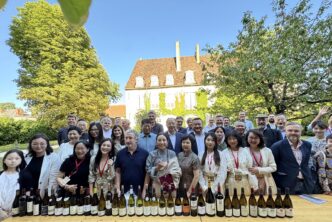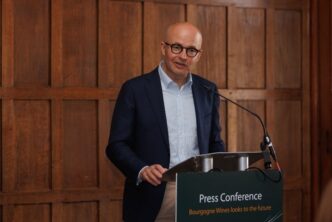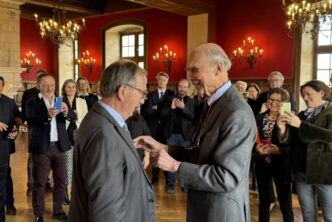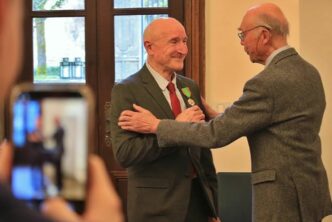Sleek, delicate and charming are probably the three best descriptors you can use when speaking of Willi Schafer’s Riesling wines. They are also the three words that best described the man.
Willi Schaefer, one of the Mosel’s and Germany’s best wine producers, passed away last week after having been quite ill for some time. I first met Willi in 2000 at his winery where I had made an appointment to taste the new vintages with him. I had just moved to Italy from the USA that year, and with my being finally (relatively) much closer to Germany, I immediately seized the opportunity to go visit my favourite German wineries. The Willi Schaefer estate of Graach, one of the Mosel’s most famous wine towns, was certainly on my short list of “greats”: after all, in the previous decade living in the USA, I and a bunch of wine-loving friends had all become devout Schaefer wine-fanatics, regularly stocking up on new vintages as well as sourcing older vintages whenever and wherever we could find them.
I remember that first visit with Willi very well. During that two week stretch in the summer of 2000, I met numerous very famous and talented wine producers, coming away with something important from each meeting. I was amazed by the concentration of Egon Muller’s best wines (quite unlike that of any other Riesling wines of the same category level), the scientific knowledge of Uli Mell (winemaker of Bassermann-Jordan in the Pfalz), the jovial bonhomie but steely resolve of Willi Haag of Fritz Haag (and his crazily painful handshake), the quiet confidence of Johannes Selbach at Selbach-Oster, the outwardly fun-loving nature but inwardly very serious approach to wine of Ernie Loosen (who would have made a great historian and geologist in another life)…in brief, I was enriched by each meeting, learning a great deal about German wine in the process. But the one who struck me as the genuinely nicest, most down to earth man of the bunch was Willi Schaefer.
Quiet and unassuming, the soft-spoken Willi talked to me at length about his vineyards, which we took time to walk and explore by foot (today, at my age and body weight, there is little if any chance of my being able to walk the Domprobst like I did back then). Willi’s love for his land was obvious, and I could tell he was really happy there among his vines. Noticing that I hade been left impressed by his obvious attachment to his vines, he proudly told me that his mother had continued to work in the same vineyards until she was something like (and I hope memory isn’t failing me now) an incredible 95 years old. Family was important to Willi: I don’t remember now if it was during that 2000 visit or the one that followed in 2001, that he told me he was looking forward to the day his son Christoph, who was studying/interning/working at Saintsbury in California at the time, would come back to the family winery (Christoph did so in 2002, along with his wife Andrea, and the pair have now been running the estate since 2015).
Willi had a delicate disposition, and so did his wines. What I liked most about them (still do) was the absolutely translucent purity, the daintiness, the vibrancy they all exhibited in spades. They were also true standards of the wines of the Graach territory. Graach is a charming little village situated right after Bernkastel (or Bernkastel-Kues) and just before Wehlen and Zeltingen as the Mosel flows down to meet the Rhine. But unlike them, Graach is slightly removed from the Mosel’s water: its more inland location means its territory is characterized by a cooler mesoclimate (farther from the heat-retentive and reflective properties of the water) that allows for wines that are even cooler-climate in personality than those of the other immediate Mosel towns. Schaefer’s innate talent was such that he was able to bring that specific aspect of Graach’s wines to the fore more often than not, clearly with distinguos relative to each site he farmed. For example, the Graacher Himmelreich vineyard gives fruitier, earlier-developing wines than those of the Graacher Domprobst, a vineyard area only a hilly crest or so removed from the former, but characterized by a much steeper slope and darker soils. Hence, its wines are deeper, earthier and slower to develop. But no matter which vineyard the grapes were picked in, Schafer’s wines were always among the daintiest, juiciest, most crystalline Riesling wines made in all Germany. They were truly beautiful masterpieces far removed from many of the overly-herbal and jarringly dry Riesling wines that are being made today.

Willi might have transmitted a sense of being a simple man in love with the countryside and his life as a farmer, but he had a real style to him, as did his wines. He will be missed.

 中文
中文




I was deeply saddened to read of Willi Schaefer’s passing. His Domprobst has been for many years my favorite Mosel Riesling. I order it in restaurants every chance I get–any pradikat. Ian D’Agata’s descriptions need no additions. I will just add that the wines are utterly free from wine maker ego. Schaefer clearly loved his vines as if they were his children. The beauty and refinement of his Rieslings hardly have equals among many first rate peers. They will likely become cult wines in a year or two. To anyone who has somehow missed them start buying soon.
I love that “…free of winemaker ego”. Very true, and very well said!
ian